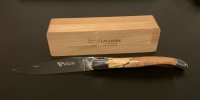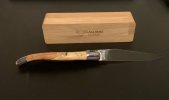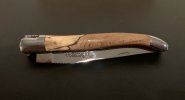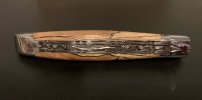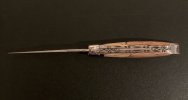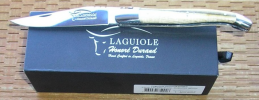Happy Birthday and what a wonderful gift !!!

There is a site with much information but it is a retail site who does not have a membership here, so I can not link to them. I will try to hit some of the high points along with my comments and opinions.
Others will likely be along to provide information as well.
Laguiole en Aubrac knives are made in Aveyron, in a small village called Espalion, not far from the mythical village of Laguiole. The Laguiole en Aubrac company was founded in 1992.
The Laguiole Knife was originally a peasant knife first manufactured in the early 1800's (1829). Refinement and embellishment have occurred since.
In 1880, the first Laguiole decorated with a fly was produced by cutlers. In its beginnings its fly was smooth, either spatula, rhombus, square, or oval. The springs were smooth, at best decorated with two lines with a knife file and a cross of Saint Andrew, itself sometimes present on the blade. The area where Laguiole Knives were produced was a region of cattle industry. Most of the handles were bovine horn which was readily available. Modern Laguiole knives may use the horn tips or other beasts as well as a plethora of other available materials from wood to mammoth etc etc. The "fly" a common pest associated with cattle. There is even a breed of cattle known as Aubrac.
1908/1909 & First World War: The bee became the emblem of the Laguiole knife. Likely reason being that a bee is more socially acceptable than a fly maybe. The First World War sounded the death knell for Laguiole cutlery. After the conflict, the workforce practically disappeared. The war after all, devastated France.
In 1950, Only two cutlery shops maintained the memory and fame of the Laguiole knife. During this period the shepherds cross began to appear on the handle. It is the miniaturization and the symbol of the Holy Cross. The Laguiole knife was said to be planted in bread to stand as a religious symbol. It thus performed a purpose for the prayer duties of those who left for several months as shepherds far afield from the churches. Much of this may be romanticized but that is the accepted explanation for the "shepherds cross" on the handle.
Some notes about your knife: Your blade is Sandvik 12C27MOD stainless steel optimized for cutlery. After heat treatment, its carbon and chromium composition gives it a unique combination of properties: very high hardness, no corrosion / rust, very good wear resistance. The stainless steel bolsters are made of 304L steel. The plates and the bee are made of 1.4016 F17 steel. Your knife appears to have what are called Double Chiseled Plates. The “guilloche” decoration is an ornamentation following the inspiration and preferences of the craftsman cutler. Thus producing almost unique pieces. So there is no real meaning to the ornamental work. Simply a craftsman's art.
I have no idea what the wood handle is on your knife and hope someone else will recognize it.
It is not uncommon to experience "blade rap" (blade strikes backspring) when snapping a blade closed on a Laguiole knife. Therefore if unsure of clearance, be sure to always "walk" the blade closed so as not to blunt the blade edge (usually in one spot near the tip) and to help maintain blade edge sharpness.
A video of Laguiole en Aubrac manufacture. You will get an idea of how handmade the Laguiole en Aubrac knives really are ...
